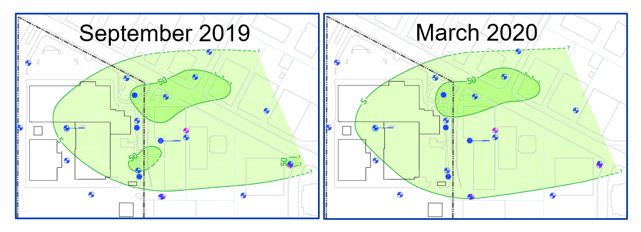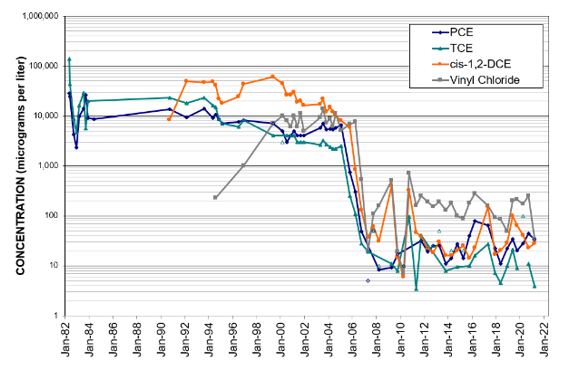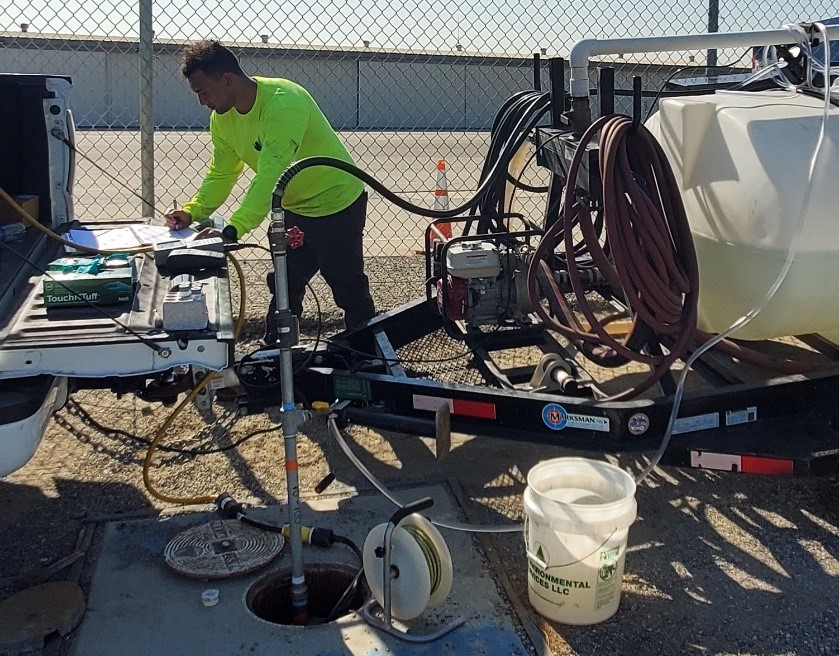Regulatory agency approval of monitored natural attenuation (MNA) as the chosen remediation method for groundwater at your contaminated site can mean a significant savings in cleanup costs. How do you go about effectively convincing regulatory agencies that MNA is an appropriate remedy for your site?
In this blog, Senior Hydrogeologist Stacia Prazen explains how using a multiple lines of evidence approach can be effective in demonstrating that sufficient natural attenuation is occurring, a key component in receiving regulatory approval.
What is Monitored Natural Attenuation?
MNA is a remediation approach that relies on naturally occurring processes to control the migration of contaminants dissolved in groundwater. MNA involves a passive approach to remediation, where ongoing monitoring is conducted in lieu of implementing potentially high-cost active remediation. The popularity of MNA has increased over the past decades as our ability to investigate and understand subsurface conditions has increased, and the realization that many active remediation technologies may not be as effective as once believed. In fact, according to the Interstate Technology and Regulatory Council (ITRC), MNA is typically the final component of the remediation process at many sites, in some cases after extensive amounts of time and money have been spent on active remediation that falls short (ITRC, 2011).
With MNA, long-term groundwater monitoring is conducted to confirm that physical, chemical, and biological processes occurring in the subsurface at a site result in a reduction in contaminant mobility or concentrations over time (i.e. natural attenuation). Processes that contribute to natural attenuation include biodegradation, hydrolysis, sorption, dispersion, dilution, and volatilization.
Biodegradation is the most prevalent mechanism, resulting in destruction of contaminant mass in the subsurface through chemical transformation. Biodegradation is a biochemical reaction that occurs when a contaminant acts as a growth substrate (food) for naturally occurring microorganisms. The reaction results in the contaminant being transformed into other potentially less-toxic chemicals (daughter products). For example, tetrachloroethene (PCE) is a federally regulated toxic volatile organic compound (VOC) commonly seen at sites impacted by chlorinated solvents. Under certain geochemical conditions, PCE will biodegrade through a series of daughter products to a benign end-product, ethene.

For many sites, the use of MNA as an approved remedy can result in an effective, cost-saving, and less intrusive approach than ongoing active remediation, making it an appealing alternative to site owners. However, MNA is not an appropriate remedy for all sites. Processes that result in natural attenuation require a specific set of conditions be present in the subsurface. Additionally, not all contaminants are readily susceptible to natural attenuation processes.
Contaminants commonly addressed by MNA include VOCs and petroleum hydrocarbons. More recently, the use of MNA has expanded to select inorganic contaminants and perchlorate. Before granting approval of an MNA remedy, regulatory agencies will require significant evidence demonstrating the occurrence of natural attenuation and that remediation objectives can be met within a reasonable time frame without posing unacceptable risk to human health or the environment. To meet these criteria, MNA is generally appropriate at sites where source zones have been actively remediated or are controlled such that additional contaminant mass is no longer entering the groundwater; and where contaminant concentrations in groundwater are relatively low.
These limitations require a thorough evaluation of site conditions to determine if MNA is a viable approach to remediation at a site. Several technical guidance protocols for MNA have been developed by the American Society for Testing and Materials (ASTM), the Air Force Center for Environmental Excellence (AFCEE), the United States Environmental Protection Agency (EPA), ITRC, and state and local entities. A common theme among the guidance documents is to use multiple lines of evidence to demonstrate that natural attenuation is occurring at a site. Convincing regulatory agencies that MNA is an appropriate remedy for your site will most likely require the use of the multiple lines of evidence approach.
Multiple Lines of Evidence
MNA as a remedy should be supported thoroughly and adequately with site specific data and analysis. Commonly, three types of site-specific information, or evidence, can be necessary to demonstrate natural attenuation is occurring:
Type 1: Plume Stability – Graphical analysis of historical contaminant data can be used to establish a trend of decreasing contaminant mass and/or concentrations over time. A clear determination of whether the groundwater plume is shrinking, stable, or expanding needs to be demonstrated. Evidence could include:
- Plume maps to illustrate changes in plume configuration over time.
- Concentration vs time plots for individual monitoring wells to evaluate concentration trends.
- Statistical trend analyses.

Type 2: Geochemical Indicators and Degradation Rates – Geochemical indicator data can demonstrate that favorable subsurface conditions exist and provide supplemental information to indirectly demonstrate that natural attenuation processes are active at a site. Concentrations of geochemical indicator compounds from both inside and outside the plume are compared. For example, the biochemical reactions involved in biodegradation of PCE can result in a decrease in concentrations within the plume of dissolved oxygen, nitrate, and sulfate; and an increase in concentrations of manganese, dissolved iron, methane, and dissolved hydrogen. The presence of these trends can indirectly support that natural attenuation is occurring. Further evidence of favorable subsurface conditions can be obtained by conducting compound specific isotope analysis. Additionally, the presence of daughter products can be an indicator of active bioremediation.

Trends in contaminant concentrations along the centerline of a plume or in individual wells located in different areas of a plume can be used to estimate degradation rates and provide additional indirect evidence. Rates can be derived using site-specific calculations, or with natural attenuation computer models, including many readily available USEPA screening models. Degradation rates can be used to predict future contaminant concentrations and cleanup times.
Type 3: Field and Laboratory Studies – In the event evidence from Types 1 and 2 are deemed inadequate evidence by the regulatory agency, field or laboratory microcosm studies conducted with actual contaminated site media may be necessary. Microcosm studies can verify the presence of a specific microbial population and identify particular natural attenuation processes at a site with the ability to degrade the contaminants of concern.
Ultimately, regulatory agencies will want to see that MNA is sustainable and will result in remediation objectives being met within a reasonable timeframe without risk to human health or the environment. Commonly, identification of contingency measures and triggering criteria will also be required. As you can see, convincing regulatory agencies that MNA is appropriate for your site is no easy task. It requires thoughtful planning to ensure appropriate site data is collected and adequately analyzed to demonstrate that natural attenuation processes are occurring at the site.
Multiple Lines of Evidence in Action
Hargis used the multiple lines of evidence approach to obtain regulatory agency acceptance of a MNA remedy for groundwater at a former manufacturing facility site in California. A combination of statistical trend analyses, compound-specific isotope analysis, and natural attenuation computer modeling was used to demonstrate the occurrence of natural attenuation and develop estimates of attenuation rates and cleanup times. The site was cleared for redevelopment in 2017 and MNA groundwater monitoring is on-going. Learn more about how Hargis supported the project from site investigations through remediation here: RCRA Closure at a Former Manufacturing Facility.
Agency approval of MNA for remediation of groundwater at your contaminated site can decrease cleanup costs. If you are seeking closure of a VOC- or hydrocarbon-contaminated site and would like to explore this option, let’s connect.
References
Integrated Technology and Regulatory Council (ITRC), 2008. Technical and Regulatory Guidance, Enhanced Attenuation: Chlorinated Organics. April 2008.

ABOUT THE AUTHOR
Stacia L. Prazen, MS, PG
Senior Hydrogeologist
Hargis + Associates, Inc.
sprazen@hargis.com
LinkedIn: https://www.linkedin.com/in/stacia-prazen/
Stacia has professional experience in hydrogeology and geology since 1998. Her experience includes hydrogeologic investigations for the aerospace, manufacturing, and public utility markets on projects regulated under the Resource Conservation and Recovery Act (RCRA) and the Comprehensive Environmental Response, Compensation, and liability Act (CERCLA) Superfund program; and water resource projects. Her current professional responsibilities include project management; soil vapor and groundwater modeling; site characterization studies including Conceptual Site Model development; remedial investigations and feasibility studies; soil vapor and groundwater remediation performance evaluations for ex-situ and in-situ remediation technologies; managed aquifer recharge; and short- and long-term project cost forecasting.
Stacia’s areas of specialization include analytic and numerical modeling, fate and transport of contaminants in groundwater, monitored natural attenuation evaluations, remediation system performance evaluations and optimization, and local and regional water resource evaluations

